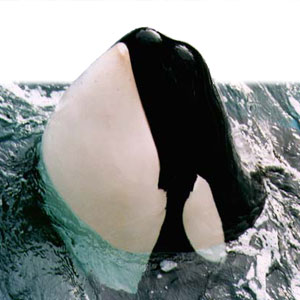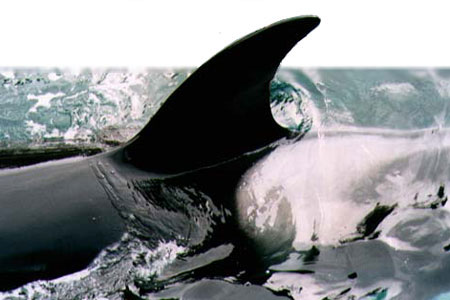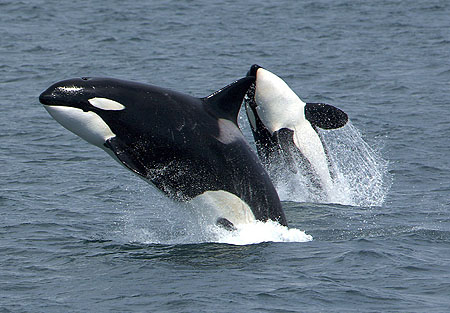


Orca (Orcinus orca)
What they look like: The orca (killer whale) is a toothed whale and is the largest member of the Dolphin family. These large marine mammals are easily distinguished by their black-and-white coloration, large dorsal fin and a sleek, streamlined body. The dorsal surface and pectoral flippers are black except for a grayish patch (saddle) that lies behind the dorsal fin and a white eyespot located just above and slightly behind each eye. The ventral surface, lower jaw and undersides of the flukes are predominately bright white. The distinctive patterns are a form of camouflage to hide their presence when in search of food. In mature males, the dorsal fin is tall and triangular and can reach a height of 1.8 m (6 ft.). Averages 5.8-6.7 m (19-22 ft.); largest males on record were 9.8 m (32 ft.) 
In most females, the dorsal fin is typically smaller and slightly falcate (curved back), reaching an average height of 0.9-1.2 m (3-4 ft.). Length: Averages 4.9-5.8 m (16-19 ft.) Females are generally smaller than males.
Size: 7 to 9.7 m (23 to 32 ft) - about as long as a small bus
Where they live: Live in coastal and offshore waters; resident pods may frequent localized waterways (bays, sounds, etc.) whereas transient pods tend to cover more extensive, varied areas.
An extended clan of orcas, known as the Southern Resident Orca community, socialize and forage in the inland waters of Washington State and British Columbia. Both male and female offspring remain with their mothers their entire lives (Orca Network).
The whales in the Puget Sound region are know as fish-eating "resident" killer whales - since they tend to eat primarily fish, catching salmon, schooled herring or rockfish. While those in the open ocean are called mammal-eating "transient" killer whales - they regularly travel several hundred miles hunting for seals, sea lions, and other large mammals. An adult orca consumes 100-300 pounds of food a day, depending on the animals size and energy needs. Behavior: Like all dolphins, orcas use sophisticated biological sonar, called echolocation. Echolocation enables them to locate and discriminate objects underwater. The vocalizations within a whale community are different from those in other communities, serving to keep the pods together. The calls also bring the pods together over large areas of water when it is not possible for the whales to see each other. 
How do Whales Swim? Their large bodies are streamlined (hydrodynamic), like a submarine, for moving through the water. Whales have flukes or a tail used for swimming. The flukes are moved in an up-and-down motion to accelerate. The dorsal fin acts like the keel of a boat; it keeps the whale from rolling side to side while swimming. Whales have pectoral flippers just behind the head. These pectoral flippers are used for steering, turning, and stopping. How do Whales Breathe? Whales have lungs they use to get the oxygen they need by breathing air (like humans). But instead of breathing through their mouth, they breathe through their nostrils, called blowholes, located on top of their heads. They can easily breathe through the blowhole without lifting their entire head out of the water. Reproduction: Females (cows) reach reproductive maturity at about 14 to 15 years. Females give birth every three to ten years, following a 17-month pregnancy. Young are able to swim and dive at birth, and they grow quickly on their mothers' milk. Calves are weaned after 12 months. Newborn calves are 7-8 feet long and weigh 136-181 kg (300-400 lb.) Lifespan: Some males have been known to live into their 40s and perhaps up to 50+ years old. Females have been known to live to 60+ years old.
Did you know?

Two mammal-eating "transient" killer whales photographed off the south side More information:
|
Animal silhouettes available to purchase »
Home | About Us | How to Participate | Biodiversity Modules | Projects | Maps | News | Resources